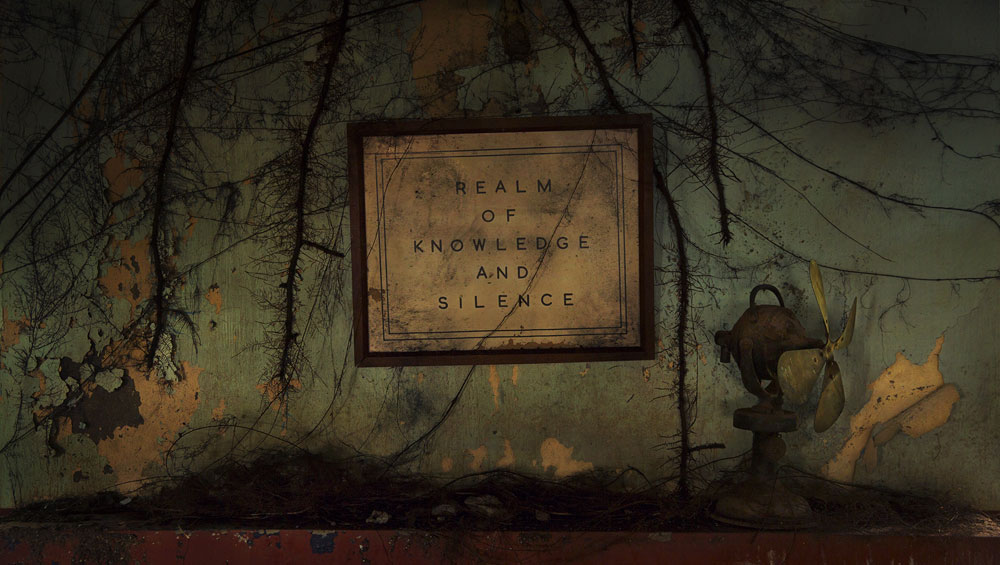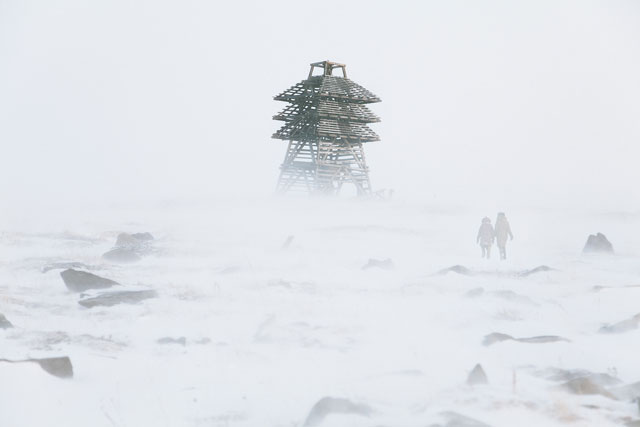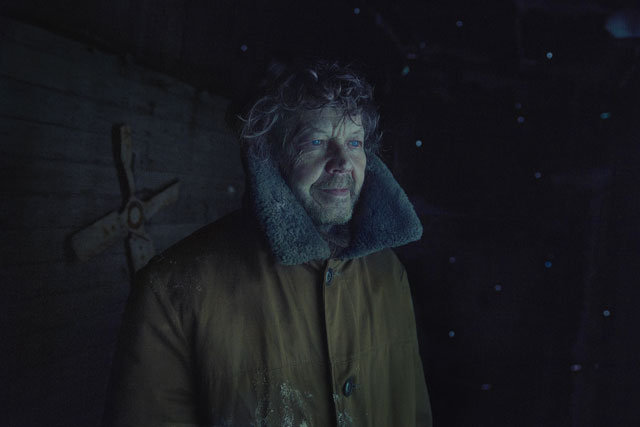
by EMILY SPICER
Evgenia Arbugaeva (b1985) has the arctic running through her veins, but when me meet on a sweltering day on London’s South Bank, she takes the heat – and the city – in her stride. But she is continually drawn back to the icy world of her birthplace and the people who live there. She is perhaps best known for her project Weatherman, in which she returned to a remote Siberian outpost in Khodovarikha, a peninsula on Russia’s northern coast, after meeting meteorologist Vyacheslav Korotki, known as Slava, who has been stationed there for 15 years. Arbugaeva visited many weather stations, but Slava’s stood out as a place out of time. It was the New Year when she went to stay with him and she brought champagne, oranges and a budgerigar with her as gifts.

Evgenia Arbugaeva. From the Amanni series, 2015.
Such gestures are typical of Arbugaeva’s approach. She is not an opportunistic photographer who snaps and runs, preferring to form friendships with anyone she photographs at length. “I always try to completely immerse [myself] in people’s beliefs and people’s worlds,” she told me. “Otherwise, what’s the point of being there?” On returning to her hometown in Tiksi on the north coast of the Sakha Republic in Siberia, after living in New York, Arbugaeva met a young girl called Tanya and the two became close. “I was remembering how I was. I completely turned into a kid again. That connected us a lot.” Tiksi looks like something from a children’s book, I suggest, but Arbugaeva tells me differently. “There’s a lot of alcoholism and it’s a very depressed town; it’s not a fairytale at all.” Yet despite the failing fortunes of her hometown, she captures a certain innocence, a timeless magic; she sees the world through Tanya’s young eyes.
Arbugaeva is sent on assignments for National Geographic, but she doesn’t view herself as a reporter or journalist “because I don’t work that way. I don’t care about telling facts, or the facts that I care about are not really newsworthy.” Arbugaeva’s images are about something else, something more intangible – an atmosphere, a quiet moment in time. Her images are reminiscent of illustrations from the most imaginative novels. And how she harnesses colour and light is a kind of alchemy.

Evgenia Arbugaeva. From the Tiksi series, 2012.
Emily Spicer: What keeps drawing you to lonely tundras and faraway places?
Evgenia Arbugaeva: I’m from one of those places. I think I’m a loner really. I’m very comfortable with being alone. I need to be in empty space. When I’m in these serene places, it’s so nice because not much happens – everything becomes important. In the big city, my mind gets cluttered and I get lost in all these things and all these thoughts. But when I’m in this emptiness, everything comes together and things make sense.
ES: Tell me about Slava. What was it like living for so many weeks in isolation with a man you had only met once before?
EA: We are very different, but we did become friends. A couple of months ago, actually, someone called me and said: “Do you know where Slava is?” This person was working for the ministry, when disasters happen, that looks for people when they get lost …
ES: The search and rescue?
EA: Yes. They said that he had left the station and hadn’t come back. He’d been lost for some time and it was very cold, around -40C. He left on his snowmobile and no one had seen him since. And I said: “I’m in London. I have no idea where he is.” I hadn’t communicated with him because there is no way to. He eventually arrived at a nearby town with frostbite. His snowmobile had broken and he had walked and stayed in some shack. He didn’t have GPS and he had to navigate through empty tundra. He’s very special in that sense. He feels the land and he can read the stars and understand the wind. I think we understood each other very well.

Evgenia Arbugaeva. From Weather Man series, 2014.
ES: Did he want to see the pictures?
EA: I did show him the pictures. He liked how the nature came out, the aurora borealis or the stars, or the snow, so he was commenting on that. But he didn’t really care about his own image. He didn’t comment on that at all.
ES: He’s been at the station for 15 years?
EA: Yes, and before that he worked at other remote stations. He was born on a ship. His mum was a cook and his dad was an engineer. He spent all his childhood there. The reason he likes to live on this peninsula is that it reminds him of the ship because, wherever he goes, he can see the sea. So from the beginning of his life, he was used to the water, to nature, loneliness, solitude.
ES: The station where Slava lives is not unlike where you went in Tanzania, in terms of it being a place out of time. That was an abandoned research centre. Can you tell me more about it?
EA: I was participating in an anthropological conference and one of the anthropologists was working on this really interesting project called Traces of the Future. They were studying former colonial scientific stations in Africa, looking at memory and nostalgia both from the side of British scientists and from local assistants. He told me about this Tanzanian station and showed me some pictures and because they feel, as anthropologists, they cannot express too much of their love for the place or the poetry of a place, he saw my work and asked me to collaborate. It was so interesting.
Before the first world war, the research centre had been a German colony and they were trying to build a coffee plantation and a botanical garden project. After the war, the British came and turned it into a tea plantation and then expanded it into a malaria research station, so they built this state-of-the-art lab and brought lots of things from Britain. There is even a red telephone booth.
They would hire local people to assist them and John Mganga, who is the protagonist in my story, was an assistant to a British scientist. There are different legends and stories about the time the British were there. For example, they were called vampires (mumiani in Swahili), because they did research for malaria, visiting the villages after midnight, when the malaria-carrying mosquito is most active, and taking samples of blood from local people, who thought it was like black magic. They would also go to study the forest at night with torches, and the local people thought they were doing something there. Actually, the villagers where John lived tried to kill him several times because he was helping the vampires.
The local people thought that when the Germans went, they left lots of gold behind, so there are treasure hunters. You can see huge holes in the forest and they pay money to magicians and voodoo people to find it. There are holes even in the German building, in the coffee plantation, in the concrete. Now, people understand that this was a lab, and, of course, nothing happens there any more, so it was challenging to capture that. But I tried to use dark colour palettes to show a bit of the mystery of the place.
ES: So the photos with John were staged?
EA: Not exactly, no. Even though he’s retired, he still comes to the station. The retired assistants are guarding the place. He goes there often to chat with his friends and when we came with the anthropologists he was one of the people showing us around. I asked him to show me whatever he wanted to show me, so we would walk around and sometimes just hang out, because I was there for two months. We would meet and have lunch and he wanted to know about where I’m from, so it was an exchange. I never really use my protagonists as a subject; nothing is preconceived, so it’s always very free. I wouldn’t push to set something up. You can feel it in the images and I don’t like that.
ES: You seem to form close friendships with the people you photograph. Do you think that’s integral to your style of photography?
EA: It’s just my process and I know that there’s a more journalistic approach. I also do editorial work for magazines and it’s faster paced and maybe not based so much on one character, but for my personal work I think it’s vital for me. If I’m not going to become close to a person, there’s no way I’ll get into their world. \I don’t want to impose what I think and what I see. I want them to show me what their world is like, to show me their favourite places, to relax. That’s why it takes time.
ES: You went back to Tiksi, where you were born, and you met a little girl there – Tanya. There’s one photograph in particular that comes to mind. She’s standing on some floating ice, dressed in a blue dress and red wellington boots and with her hair in plaits, and I wondered if you had dressed her that way. I wondered how far that image was staged.
EA: I worked on this project for two years, so I became good friends with her family, and my family became good friends with her family. They spend the summer vacation with my parents. I talk on the phone with Tanya all the time now. She has just got into college; she’s going to be a heart surgeon. I very quickly stopped thinking of her as just a character in a story.
When we met, she was just turning 13 and all of her classmates were in this teenage phase. There is not much to do in the town. Already at that time, she had two classmates who were pregnant. She felt that there was such a big gap between her and her friends. Her mum is a teacher, her dad is a doctor, and they created a kind of bubble around her. She preferred sometimes to hang out with me more than with her friends, who were already somewhere else; you know, sitting drinking beer in an abandoned factory or something. Tanya wasn’t even allowed to drink Coca-Cola, so one day I bought Coca-Cola and we climbed into this abandoned cowshed and I opened the bottle, and she was like: “Oh, my god! I can’t believe we’re actually doing this!”
Going back to this picture, there was this beautiful day – a very sunny, very rare, warm day – and she said: “OK, let’s go and can I please wear this dress? Because I think it’s going to be too small for me tomorrow!” It was already a bit too small, but she really wanted to be photographed in it. It was a childhood dress, really, a little-girl dress. And she asked her mum to braid her hair and we went out. So I think this picture is, now that I look at it, [Tanya] saying goodbye to her child self. She’s very unusual, because she never wanted to grow up. I’m like: “Girl, I hear you!”
ES: How much of the look of your photographs is created in post-production?
EA: I photograph on raw format and, of course, it has to be developed as you would do with film, so I do work on the tonality, but I’m not changing the image so much. That’s why it’s important for me to have the colour palette consistency within the series. The light should be constant, so that it produces a consistent tonality. The main work is editing, to take out the images that don’t match. I think of the colour palette as the main theme in a musical composition and, within this theme, other things are happening. It connects all the elements and it puts you into this mode of seeing this other world, this special atmosphere – the wholeness of the world I’m trying to capture.
ES: What is it about places frozen in time that appeals to you?
EA: That moment of past and present – I like to work in that time space. When you think of your own past, you always think poetry, you know. You tell a story, a wonderful story, even if you’ve had a very dramatic experience. I like that language of the past. You can talk about it more poetically, and I love it when the people that I photograph tell me about where they are and their memories. They talk beautifully and they tell me something and it transforms into an image, into a certain story that I build in my head, and then, through this story, I begin to see things. I have to tweak my brain to a certain wavelength based on their stories and then transform my brain when I start to look at the reality through the layers of their memories.
ES: What else do you draw on to help reach that mental “wavelength?”
EA: I listen to certain music and read certain books and create a bubble around myself that will enhance the feeling of a place. In Tanzania, for example, I spent a lot of time in the library, this really beautiful library with dusty volumes on natural history. They have illustrations with the thin paper covering. I was the only one there, so I would open the books and lay them out. With Tiksi, I was looking at Soviet children’s books because Tanya’s mum is a teacher of first to sixth grade. Every picture has to tell a story, but the child can make up any story that he or she wants within this little picture. The colours are very bright and there’s a lot of mystery, and also a lot of play within the illustrations. So I looked a lot at that. With Weatherman, I listened a lot to music with trombones and cellos.
ES: Do you use literature for inspiration?
EA: I do. In terms of literature, I’ve always been inspired by magical realism of course, especially Gabriel García Márquez.
ES: When you were talking about Tanzania, Márquez’s One Hundred Years of Solitude was one of the first things that came to mind.
EA: I started reading him when I was a teenager and I love his language and the way he constructs his worlds in such a beautiful way. Somehow, I want to do this in my work – not the same – but as similar as possible. Of course, I work hard and have moments when I think, what am I doing? But generally, I also look at things like that, which is not very practical, always making up stories and always believing in magic and symbols and signs.
ES: Where will your next project take you?
EA: I want to go back to the Arctic because I’ve been working in the tropics and I really want to return to snow. I haven’t experienced a proper winter for a long time. I was at my friend’s place and she had this white plate with a kind of cottage cheese, a Russian thing, with white yoghurt on top, and she put it on the white table. I was staring at it, thinking, I want to go there! And when I was flying to Indonesia I was asleep on the plane and then I woke up and looked out and there were just clouds. It looked like tundra. And I thought I’m going home, wait, no, where am I going? So I feel like I really need to go back. I’m travelling in September to some really remote islands in the Arctic Ocean. I’ll be collecting all of the loners of the Arctic again.